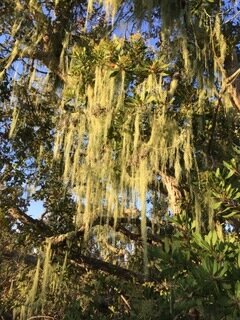By Molly Machin
Many park visitors admire the beautiful grey-green sheaths that drape down from the branches of oak trees and sway in the wind. Often, they mistake them for Spanish Moss. Spanish Moss (Tillandsia usneoides) is a nonparasitic plant that is supported by another plant and has aerial roots to capture moisture from the atmosphere. True Spanish Moss produces flowers and seeds.
Native Americans told early explorers that it was called itla-okla which means tree hair. French explorers called it Spanish Beard and Spanish explorers called it French Beard. Eventually it came to be known as Spanish Moss. Spanish Moss does NOT grow in California. It requires a humid climate and can only be found in the Caribbean and the southern United States.
What we see at La Purisima Mission is Lace Lichen. You can see from the photo the lace-like appearance of a sample taken from the mission. Lace Lichen (Ramalina menziesii) is so common it has been designated The California State Lichen. Currently the definition of lichen is being overhauled and textbooks are being rewritten.
In 1868, a Swiss botanist named Simon Schwendener was the first person to demonstrate that lichens are composite organisms, consisting of fungi that live in partnership with microscopic algae. The algae use sunlight to make nutrients for the fungus, while the fungus provides minerals, water, and shelter. This mutually beneficial relationship is referred to as symbiosis. Since they were first identified, lichens have been found all over the world, often in the most inhospitable environments on the planet. To date scientists have NEVER been able to grow lichens in the lab. New genetic research suggests that lichens are in fact a beneficial relationship between THREE organisms: one algae and two kinds of fungus. This new information is reshaping what we know about lichens and our world.
That’s how science works. When new information becomes available existing concepts are refined. As docents we need to continue learning so we can refine and improve our various contributions to the mission experience.
The California State Lichen, La Purisima Mission




